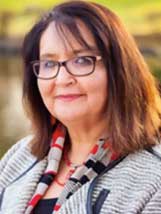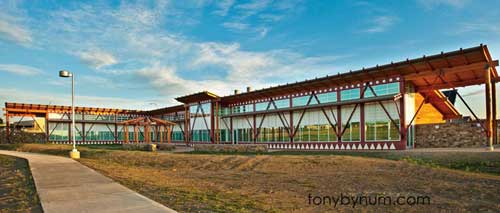[The Montana Professor 25.2, Spring 2015 <http://mtprof.msun.edu>]
Billie Jo Kipp, PhD
President
Blackfeet Community College

In October of 1974, the Blackfeet Tribal Business Council chartered the Blackfeet Community College by executive action to "provide post-secondary and higher educational services" to the residents of the Blackfeet Nation and surrounding communities. The impetus for this action grew from early tribal efforts to provide an educational opportunity to its residents in a physically, climatically, and culturally isolated area. As Blackfeet, we not only love our children but we revere our elders, as well. We look to the older generations to pass down their extensive bodies of traditional knowledge. This traditional knowledge was preserved in the minds, spirit, and heart of the Amskapi Pikuni, and it is important to remember that it was passed down in the language given to them at the beginning of time. Blackfeet Community College (BCC) embodies this wisdom and incorporates indigenous knowledge in the modern education of our Native scholars.
Education was the vision of our ancestors, just as it is the vision of BCC. The Blackfeet linguistic and cultural ways are old and they extend far back to creation. Such ways provide the basis for progress in education. BCC is a cultural and educational tribal college that promotes learning as well as a place that honors the tribal identities of the Blackfeet people. BCC develops the potential of minds and fulfills dreams of an education.
The Blackfeet Tribe of Montana is one of the largest native groups in the Northwest. The tribe has approximately 16,000 enrolled members, and approximately 8,500 reside within the reservation boundaries. The Blackfeet Tribe is traditionally known in the native language as the Pikuni, or "Beings of Abundance." The Creator gifted us generously, and the Pikuni were rich in the necessities of life. Respect for life in all forms has traditionally been a foundation of the Blackfeet culture.
Over the last 200 years, the life of abundance has been altered drastically. Starvation winters, the Baker Massacre and other U.S. Department of War endeavors, and numerous smallpox epidemics reduced the population from 60,000 people to less than 400 nuclear families by 1893. The Blackfeet people have been subjected to intense cultural disruption over the last four or five generations. Values were annihilated and students abused at mission schools and government boarding schools; Blackfeet understandably came to mistrust educational institutions. Traditional social systems were disrupted, and total tribal grief is but one outcome for the Amskapi Pikuni (Southern Blackfeet). There are a few elders remaining who know personal accounts and have personally witnessed these events and observed the effects of this devastation on their families.
Approximately one-fourth of the reservation population lives on small ranches and family homesteads reached by unpaved roads in every direction, from the Canadian border to Birch Creek, 80 miles south: and from the Rocky Mountain/Glacier Park border to Cut Bank Creek, 75 miles east. The population of the Blackfeet Reservation and nearby communities (Cut Bank, Valier, and Dupuyer) is comprised of approximately 75% Blackfeet members or tribal descendants.
The Blackfeet child is in the top ten for those living in poverty; the reservation ranks as the 5th poorest reservation in the United States. The current Blackfeet One Stop Center services 2,217 welfare recipients, and this population includes 748 two-parent families affecting the lives of 1,416 children. Currently, the Blackfeet TANF program provides social and financial support to 360 children age five and under. The risk of poverty for children born to married parents or co-habiting couples is very high.
Unemployment is an enormous problem. The Bureau of Indian Affairs reported in the 2000 Indian Labor Force Report that of 5,359 employable civilians, 74% were unemployed and 22% of those employed were below the poverty level. The average Blackfeet resident survives on approximately one-third the average national income and nearly one-half of the Montana state average income—$5,574 per year. According to the 2000 US Census Bureau, the Blackfeet Reservation (most of Glacier County) is 35th of the 100 poorest counties in the United States. Most notably Tom Rodgers presents the following analogy: "[T]he annual [native] unemployment rate is 69 percent. The national unemployment rate at the very peak of the Great Depression was around 25 percent. That means that each year the Blackfeet people, whose aboriginal lands once comprised Glacier National Park, suffers an employment crisis nearly three times as severe as the Great Depression."1
The social and economic conditions on the reservation explain why 90% of students receive Pell grants. Social and economic instability contributes to unusually high levels of attrition and low student graduation rates. Recent statistics report that the school dropout rate is 65%.
Blackfeet Community College is charged with the educational needs of the Blackfeet and expected to respond to local workforce trends. The education and training of the Blackfeet Tribe is the critical focus of the mission and vision for improvement of the reservation economy.
Blackfeet Community College (BCC) has seen an increase in enrollment of around 13% from FY2013 to FY2015 with a total student body of 484; 96% are Native American. A comprehensive recruitment plan, an increased number of program of study offerings, increased student-led research capacity, and the implementation of student support services as well as scholarships have provided BCC with strategic initiatives to address enrollment growth. BCC employed 20 full-time and 17 part-time faculty in the 2014-15 academic year; over 85% are Native American. BCC's eight academic and two workforce divisions offer five Associate of Arts, five Associate of Science, and five Associate of Applied Science degrees. Additionally, six One-Year Certificates and one Endorsement are offered for students and community members engaged in the local workforce.
The primary source of operational funding for BCC is the Tribally Controlled Community College Assistance Act (TCCCA, 1978). Funding for this act is presented to Congress as part of the President's annual budget. Congress then determines the final appropriations, and this amount is then distributed to all tribal colleges and universities (TCU) on a formula basis. The amount of funding per TCU is determined through each TCU's Indian Student Count (ISC). The TCCCA appropriations have increased over the past ten years, but the level remains well below what other public higher education institutions in the United States receive per Full-Time Equivalent (FTE).
The college is underfunded while trying to meet the significant support needs of an impoverished community. To meet financial needs, the college works hard to win federal, state, and private grants that supplement general fund requirements.
BCC continues to strive for providing quality education to those most in need. The development of training programs, provision of transferable academic courses, and meeting the holistic needs of the students has become the synergistic balance that most mainstream community colleges aren't required to address. Providing rigorous academic education—as well as community-based job skills—and developing cutting edge research at BCC has proven to be the trifecta of success for Blackfeet Community College.
In an attempt to assure more gainful employment, BCC has focused on the nation's fastest growing industry—healthcare—and developed several Health Care Paraprofessional programs. This has become a notable success for BCC. Along these lines, we offer medical billing and coding, certified nursing assistant training, emergency medical tech training, and phlebotomy and CNA/EMR/EMT refresher courses. The BCC School of Nursing is addressing the overwhelming deficit of native nurses by training and education through the LPN and RN programs.

A unique attempt to support the community is the development of the Behavioral Health Aid program. This project will empirically evaluate the efficacy of a culturally-adapted and empirically-based curriculum designed to train a behavioral workforce in core mental health domains within a tribal college. The rural and remote location of the Blackfeet Community College has created barriers towards accessing educational opportunities for this tribal community. The BHA curriculum is providing entry-level employment opportunities to improve the health infrastructure of the community and help address posttraumatic stress, depression, and substance use disorder within rural/remote reservation populations in Montana. This cutting edge project exemplifies the action-oriented academic programming that improve the health of tribal communities.
BCC has focused on solar construction to provide a new venue for our students to attain a unique job skill. The Workforce Development Division is responsive to current building trends and is providing plumbing, electrical, and carpentry classes. The classes offer certificates and degrees to support the building industry. This division is constantly monitoring local construction trends to assure that the Blackfeet are trained and positioned for job placement.
The positioning of BCC as a minority research institution has increased the capacity for the Blackfeet to be qualified partners in any research project. Currently on the campus of BCC in the platinum LEED Southwind Lodge, students are involved in projects in the BCC Metabolic Research Center. The Center has the goal of improving the health of members of the Blackfeet Nation.
The best approach to achieving this goal is to enhance the capacity of the tribe itself to address its own health disparities through the development of interventions that are considerate of and consistent with Blackfeet cultural beliefs. We also believe that Native researchers are best suited and prepared to perform both research and effective interventions in Indian Country and that BCC-MRC could eventually be the vehicle through which the Blackfeet community does indeed address its own health problems. This program is a partnership of BCC and Montana State University and is carried out in a cutting edge research lab.
From the youngest, bright-eyed students who are just beginning their educational journey to the older students who are juggling classes, jobs, and child rearing, Blackfeet Community College benefits the entire tribe and community.
BCC is an institution that is guided by tribal values and incorporates methods of learning geared towards American Indian students to more aptly prepare students for success. Lack of funding and the minimal resources of the tribes continue to be obstacles, but BCC's perseverance confirms the belief that community-based colleges of their own can also strengthen their tribal nations.
Endnote
[The Montana Professor 25.2, Spring 2015 <http://mtprof.msun.edu>]